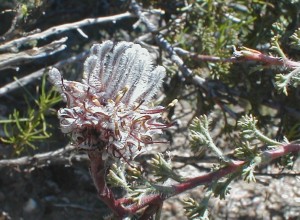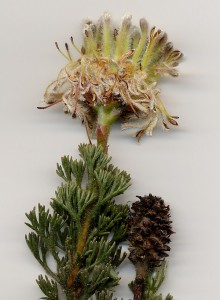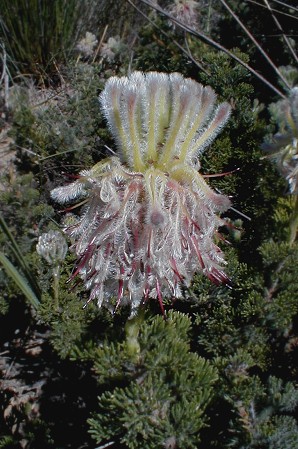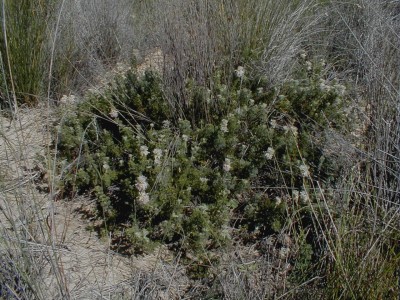
Home
Mission
Overview of Project
Project Staff
Sponsors
Achievements
Checking, Illustrations
Upcoming Activities
Id and Species Lists
Protea Information
Protea Gallery
Growing Proteas
Interim Dist. Maps
Publications
Afrikaanse Inligting
![]()
Serruria delphiniifolia Rediscovered after 192 Years? No!
15 October 2001
John Rourke has been working hard on our Serruria, and following a field trip with the Protea Atlas atlassers on 2 October 2001 to look at the specimens atlassed by Ruth Smart and others, has come to the following preliminary conclusions. However, more material is still required and the Serruria incrassata complex may require a more detailed revision.
The Serruria described as Serruria delphiniifolia is NOT what we found. This species, described by Richard Salisbury in 1809 is more like Se incrassata, having curved styles.
The Serruria atlassed by Ruth Smart and Ismail Ebrahim is in fact Serrruria scoparia. This was described by Robert Brown in 1810, and has not been recorded since. This was originally collected at Ruth's localities, which is now all fields and chicken farms. Only two of Ruth's three plants are still alive in the railway verge.
 Far more fun, is that the Serruria investigated and atlassed from
Moreesberg also appears to be Serruria scoparia. It has the same straight style
and the fuzzy hairs (Serruria incrassata has strongly curved styles and hairs
flat on the petals, and a very long flower stalk), but it is far more silver and appears
in the field (until you look at the flowers with a magnifying glass), more sparse,
prostrate and incrassata-like. It is unusual for species to occur on two very different
substrates (deep sands at Hermon and solid shale rocks at Moorreesberg), but there are no
real differences between the populations.
Far more fun, is that the Serruria investigated and atlassed from
Moreesberg also appears to be Serruria scoparia. It has the same straight style
and the fuzzy hairs (Serruria incrassata has strongly curved styles and hairs
flat on the petals, and a very long flower stalk), but it is far more silver and appears
in the field (until you look at the flowers with a magnifying glass), more sparse,
prostrate and incrassata-like. It is unusual for species to occur on two very different
substrates (deep sands at Hermon and solid shale rocks at Moorreesberg), but there are no
real differences between the populations.
Given this distinction, Se scoparia has been atlassed 11 times during the atlas project (all as Se incrassata - it was never seen in flower). (Five times near Leliedam, 3 times near Goudmynsberg and twice from La Fontaine - the type locality). Atlassers were AGR, DJL, SMR, and VDW. Flowering material is still required from Lelieddam.
Tony Rebelo
September 2001
 Has Forlorn Spiderhead - Serruria delphiniifolia been
rediscovered after a 192 year absence near Hermon? The recently found species is closely
related to Silverpaw Spiderhead - Serruria incrassata from the shale hills of
Joostenberg. However, it is quite distinct in having yellow not silver petals and
spreading not clasping hairs on the petals. The flowerhead stalk is also much shorter and
the branches are not quite as spreading. It is probably a good species, but more work is
needed to confirm this. The identification was done by Dr John Rourke of the
Compton Herbarium but this is still provisional. More material is needed to
compare the plants to the original material collected by Niven. Only then can we begin the
detective work of confirming the identification. It may still, well be a new species!
Has Forlorn Spiderhead - Serruria delphiniifolia been
rediscovered after a 192 year absence near Hermon? The recently found species is closely
related to Silverpaw Spiderhead - Serruria incrassata from the shale hills of
Joostenberg. However, it is quite distinct in having yellow not silver petals and
spreading not clasping hairs on the petals. The flowerhead stalk is also much shorter and
the branches are not quite as spreading. It is probably a good species, but more work is
needed to confirm this. The identification was done by Dr John Rourke of the
Compton Herbarium but this is still provisional. More material is needed to
compare the plants to the original material collected by Niven. Only then can we begin the
detective work of confirming the identification. It may still, well be a new species!
The only herbarium record to date was collected by James Niven on the dry ascents of mountains near Paarl probably around 1800-1805.
It was described by Richard Salisbury in 1809 in Joseph Knight's famous book "On the cultivation of the plants belonging to the natural order of Proteeae". It does not appear to have been seen or collected since.
The name delphiniifolia means Larkspur-leaf.
It appears as if this plant is very close to extinction. It is only known from three sites - one with one plant, one with three plants and a big population of over 20 plants, just north of Hermon.
It flowers in September-October. It survives fires by resprouting from an underground rootstock. Its mistake is liking soil that is suitable for grapes.
Serruria delphiniifolia was suggested in PAN 9 (March 1991) to be an "imperfectly known species". This status can perhaps be changed to that of a "good species"?
The first flowering specimens were found by Terry Trinder Smith in Ismail Ebrahim's Protea Atlas Plot while participating in the Cape Lowlands Project run by the Botanical Society of South Africa's Cape Conservation Unit, sponsored by Table Mountain Fund (WWF-SA) and Mazda. The Specimen number will be based on the Protea Atlas SRS, IEB 010913 01.
Serruria delphiniifolia was previously atlassed on Ruth Smart's Protea Atlas SRS plots SMRY00727 04 and 10, as Serruria incrassata, east of Riebeek West. This was an easy error to make given that both plants are resprouters and Serruria delphiniifolia was not in flower when atlassed in July 2000.
Serruria delphiniifolia is in the Skirted Spiderheads section (Phylecoideae).
Tony Rebelo, the Scientific Officer for the Protea Atlas Project suggested that "It is a pity we found it so late. The second edition of SASOL Proteas - a field guide to the proteas of southern Africa - is landing at Cape Town any day now. So it is too late to include in the book. Still it is lucky that we found it when we did. It is only known from three sites between the farmlands! A few more years and it may have been extinct without ever having been recorded".

The habit of a typical Serruria scoparia plant

Back Protea Atlas Project